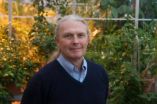(Press-News.org) Dartmouth plant biologist C. Robertson (Rob) McClung is not your typical clock-watcher. His clocks are internal, biological, and operate in circadian rhythms—cycles based on a 24-hour period. Living organisms depend upon these clocks to keep pace with the Earth's daily rotation and the recurring changes it imposes on the environment. These clocks allow the plant or animal to anticipate the changes and adapt to them by modifying its biology, behavior, and biochemistry.
"If you know that the sun is going to go down, and if you are a photosynthetic plant, you have to readjust your metabolism in order to make it through the night," says McClung.
Seeking Knowledge Among the Weeds
McClung, the Patricia F. and William B. Hale 1944 Professor in the Arts and Sciences, uses the Arabidopsis plant in his research on the mechanisms that affect plant behavior and its genetics. He jokingly refers to it as "an inconsequential little weed," but holds it in high esteem as an experimental test bed.
According to the National Institutes of Health, this member of the mustard family is the model organism for studies of the cellular and molecular biology of flowering plants. "Because plants are closely related, it is quite likely that knowledge derived from Arabidopsis studies can be readily transferred to agronomically important species," says McClung.
Water and the Changing Climate
McClung sees internal clocks as increasingly important in the face of global climate change, and to agricultural productivity in particular. "In the context of climate change and the need to exploit increasingly marginal habitats, fuller understanding of clock mechanisms may offer strategies to improve crop productivity," says McClung. "We need to know how an organism measures time and how it uses that information to coordinate its physiology and behavior."
Water is the landscape on which biological clocks and climate change intersect. Agriculture consumes the vast majority of our water, and warmer and dryer conditions are predicted for much of the agricultural land of the United States. This is based on our current understanding of the changes predicted to be associated with global warming and in this scenario our aquatic resources will become increasingly scarce.
Water is lost during the gas exchange that takes place in photosynthesis—carbon dioxide in, oxygen out—through small pores in the surface of leaves that periodically open and close under the control of a biological clock. Exercising control over this clock could be a means of conserving water. "We know that these little cells on the surface of the leaf are controlled by the clock," says McClung. "It could be that different clocks regulate it slightly differently, and we would like to find the best clock, fine-tune it, and perhaps optimize the ability to get CO2 in without losing water."
Water figures prominently in another aspect of plant physiology. Water moves up through the stem to the leaves, involving proteins called aquaporins. "There is a big family of genes that encode aquaporins, and in Arabidopsis the circadian clock governs the expression cycles of about a third of those genes," says McClung. "That suggests there is mechanism to actually regulate this hydraulic conductivity over time, constituting another instance where the clock is involved in water use efficiency."
New Frontiers
Together with colleagues in Wyoming, Wisconsin, and Missouri, McClung has been looking at another a crop, Brassica rapa, a close relative of which is the source of canola oil. With a five-year National Science Foundation grant of more than $5 million, the group is investigating Brassica's circadian patterns, looking at inheritance and water use efficiency. "We have mapped 10 genetic regions that are associated with water use efficiency," says McClung. "We have also traced circadian parameters to most of those same areas, suggesting a link between the two. This association suggests that we could potentially use the clock to manipulate water use efficiency."
In a related project, McClung will be working with soybeans, attempting to correlate circadian period length with latitude. "If we can understand the clock, we might then manipulate the clock in ways to achieve desired goals, including water use efficiency and better yield."
Why and How?
McClung feels strongly that this sort of basic research has the potential to contribute in significant ways to food production increases. "Whether or not we achieve that increase or whether it allows us to fertilize a little less and so pollute a little less but maintain the same productivity level, anything in the net direction that is positive is going to help," he says. "We can't necessarily say exactly how it will help, but I think it's not unreasonable to think that this very basic research can have a real world impact, and one hopes it will."
Sidebar:
Genetically Modified Organisms (GMOs)
"We will need to genetically modify our plants to control our circadian biological clocks," says Professor Rob McClung. "Every domesticated plant and animal that we have today is already genetically modified. None of them are as they are found in nature. We have manipulated their genes by selective breeding and creating hybrids."
To produce the corn we eat today, prehistoric farmers first had to find some variant that had a desirable trait, keep its seeds and plant them, repeating the process for countless generations to bring out that trait. That is selective breeding and it produced a plant whose genome was modified.
To make a tomato plant resistance to a particular disease or pest, we might find some related pest-resistant species in the wild and cross it with our garden variety tomato to produce a hybrid. Successive crosses would preserve the "tomato-ness" while selectively retaining that little bit from the wild relative that resists tomato-eating bugs.
"Along with introducing the gene or set of genes encoding resistance, we may have also brought in a whole bunch of other ill-defined genes on either side," McClung says. "We don't know the extent of it. We don't know what else is in there. While some regard this as a 'natural' approach, the unknown genetic fellow travelers could be problematic or even dangerous."
For more than 20 years, we have possessed the technology to precisely insert a single gene, making one change and only one change, producing what is known as recombinant DNA. "We are modifying genes in a much more informed way and precise way, targeting specific genes and manipulating those," he says.
"Nevertheless, there is vocal opposition to this practice, in spite of the fact that we have been doing it for decades and there is yet to be a single example of anything bad happening from that," says McClung. "It is a philosophical standpoint based on a lack of understanding. People don't understand the science and they come up with a lot of arguments against it."
The dilemma rests on timing. Conventional breeding, though imprecise and unpredictable, is a workable but lengthy process. Recombinant DNA is fast. In a world beset by overpopulation, famine and global climate change, McClung questions whether we can really afford the time to wait.
INFORMATION:
Dartmouth research: The clocks are ticking and the climate is changing
2012-11-16
ELSE PRESS RELEASES FROM THIS DATE:
Dartmouth research pursues problematic polymers
2012-11-16
"You look at the material world and see objects and how you can use them. I look at the material world and see a fascinating hidden life which is within our control, if we can only understand how it works," says Jane Lipson, the Albert W. Smith Professor of Chemistry at Dartmouth. Lipson looks at things from the point of view of both a chemist and a physicist. "What I do lies between the two sciences, and there is some engineering thrown in there, too," she says.
Lipson is a polymer chemist who, by definition, deals with long chain molecules composed of repeating structural ...
Are we closer to understanding the cause of deadly sepsis?
2012-11-16
New Rochelle, NY, November 13, 2012—Following an infection, dysregulation of the immune system can result in a systemic inflammatory response and an often fatal condition called severe sepsis or septic shock. Sepsis is not uncommon, yet its cause and underlying immune dysfunction remain poorly understood. Regulatory T cells (Tregs), a component of the immune system, now appear to have an important role in suppressing the immune response in advance of sepsis, and understanding this role may lead to new therapeutic strategies for improving patient outcomes, as described in ...
Gene distinguishes early birds from night owls and helps predict time of death
2012-11-16
BOSTON – Many of the body's processes follow a natural daily rhythm or so-called circadian clock. There are certain times of the day when a person is most alert, when blood pressure is highest, and when the heart is most efficient. Several rare gene mutations have been found that can adjust this clock in humans, responsible for entire families in which people wake up at 3 a.m. or 4 a.m. and cannot stay up much after 8 at night. Now new research has, for the first time, identified a common gene variant that affects virtually the entire population, and which is responsible ...
ORNL recipe for oxide interface perfection opens path to novel materials
2012-11-16
By tweaking the formula for growing oxide thin films, researchers at the Department of Energy's Oak Ridge National Laboratory achieved virtual perfection at the interface of two insulator materials.
This finding, published in the journal Advanced Materials, could have significant ramifications for creation of novel materials with applications in energy and information technologies, leading to more efficient solar cells, batteries, solid oxide fuel cells, faster transistors and more powerful capacitors.
The research team, led by ORNL's Ho Nyung Lee, demonstrated that ...
Teenagers urged to exercise to ward off bone disease
2012-11-16
An international team, including an expert from the University of Exeter, has found evidence that adolescents who spend long periods engaged in certain sedentary activities are more likely to have low bone mineral content in parts of the body where it can be an indicator of the risk of developing osteoporosis.
In the research, published by PubMed on November 15, the team found that studying put girls at particular risk, while for boys leisure internet use posed the greatest threat. Scientists found that participating in at least three hours of certain sports could significantly ...
How does groundwater pumping affect streamflow?
2012-11-16
Groundwater provides drinking water for millions of Americans and is the primary source of water to irrigate cropland in many of the nations most productive agricultural settings. Although the benefits of groundwater development are many, groundwater pumping can reduce the flow of water in connected streams and rivers—a process called streamflow depletion by wells. The USGS has released a new report that summarizes the body of knowledge on streamflow depletion, highlights common misconceptions, and presents new concepts to help water managers and others understand the effects ...
USDA funded research leads to key discoveries in the pig genome
2012-11-16
WASHINGTON, Nov. 15, 2012 – Research conducted and supported by the U.S. Department of Agriculture (USDA) has led to a new analysis of the pig genome, revealing new similarities between pigs and humans that could potentially advance biomedical research significantly. Additional findings from the study, reported today in the journal Nature, may also lead to better breeding strategies, improved pork production and improvements to human health. The research was conducted by a global team of scientists as part of the International Swine Genome Sequence Consortium (ISGSC).
"This ...
New research explores why we remember and why we forget
2012-11-16
Psychological scientists are exploring the mechanisms that underlie memory to understand why we remember certain things and why we forget others. Read about the latest research on memory published in the November 2012 issue of Psychological Science.
Retrieval-Induced Forgetting Predicts Failure to Recall Negative Autobiographical Memories
Failure to retrieve memories may not always be a bad thing - we might, for example, prefer to forget about certain instances of heartbreak or failure in favor of some of the more positive events from our lives. In this study, researchers ...
Fire the coach? Not so fast, says new study by University of Colorado, Loyola professors
2012-11-16
Fire the coach? Not so fast says a new study of elite college football teams.
Professors from the University of Colorado and Loyola University Chicago studied what happened to the records of college football teams that replaced a head coach for performance reasons in the Football Bowl Subdivision (formerly Division 1-A) between 1997 and 2010. Over this period, an average of 10 percent of FBS teams fired their coach each year because of the team's poor performance on the field.
The authors used statistical methods to compare groups of teams that were similar except for ...
New whale shark study used metabolomics to help understand shark and ray health
2012-11-16
New research from Georgia Aquarium and Georgia Institute of Technology provides evidence that a suite of techniques called "metabolomics" can be used to determine the health status of whale sharks (Rhincodon typus), the world's largest fish species. The study, led by Dr. Alistair Dove, Director of Research & Conservation at Georgia Aquarium and an adjunct professor at Georgia Tech, found that the major difference between healthy and unhealthy sharks was the concentration of homarine in their in serum—indicating that homarine is a useful biomarker of health status for the ...



